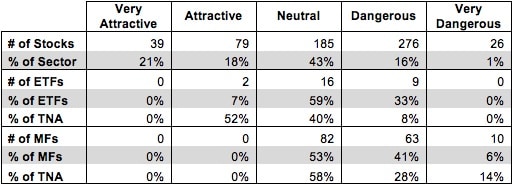The Information Technology sector ranks second out of the ten sectors as detailed in my Sector Rankings for ETFs and Mutual Funds report. It gets my Neutral rating, which is based on aggregation of ratings of 27 ETFs and 155 mutual funds in the Information Technology sector as of July 8, 2013. Prior reports on the best & worst ETFs and mutual funds in every sector are here.
Figures 1 and 2 show the five best and worst-rated ETFs and mutual funds in the sector. Not all Information Technology sector ETFs and mutual funds are created the same. The number of holdings varies widely (from 25 to 418), which creates drastically different investment implications and ratings. The best ETFs and mutual funds allocate more value to Attractive-or-better-rated stocks than the worst ETFs and mutual funds, which allocate too much value to Neutral-or-worse-rated stocks.
To identify the best and avoid the worst ETFs and mutual funds within the Information Technology sector, investors need a predictive rating based on (1) stocks ratings of the holdings and (2) the all-in expenses of each ETF and mutual fund. Investors need not rely on backward-looking ratings. My fund rating methodology is detailed here.
Investors seeking exposure to the Information Technology sector should buy one of the Attractive-or-better rated ETFs or mutual funds from Figures 1 and 2.
Get my ratings on all ETFs and mutual funds in this sector on my free mutual fund and ETF screener.
Figure 1: ETFs with the Best & Worst Ratings – Top 5

* Best ETFs exclude ETFs with TNAs less than $100 million for inadequate liquidity.
Sources: New Constructs, LLC and company filings
Figure 2: Mutual Funds with the Best & Worst Ratings – Top 5

* Best mutual funds exclude funds with TNAs less than $100 million for inadequate liquidity.
Sources: New Constructs, LLC and company filings
Eight mutual funds are excluded from Figure 2 because their total net assets (TNA) are below $100 million and do not meet our liquidity standards.
Technology Select Sector SPDR (XLK) is my top-rated Information Technology ETF and Fidelity Select Portfolios: Computers Portfolio (FDCPX) is my top-rated Information Technology mutual fund. XLK earns my Attractive rating and FDCPX earns my Neutral rating.
PowerShares Lux Nanotech Portfolio (PXN) is my worst-rated Information Technology ETF and Rydex Series Funds: Electronics Fund (RYELX) is my worst-rated Information Technology mutual fund. PXN earns my Dangerous rating and RYELX earns my Very Dangerous rating.
Figure 3 shows that 118 out of the 605 stocks (over 39% of the market value) in Information Technology ETFs and mutual funds get an Attractive-or-better rating. However, only 2 out of 27 ETFs (52% of total net assets)and no mutual funds in the sector get an Attractive-or-better rating.
The takeaways are: mutual fund managers allocate too much capital to low-quality stocks and Information Technology ETFs hold poor quality stocks.
Figure 3: Information Technology Sector Landscape For ETFs, Mutual Funds & Stocks

Sources: New Constructs, LLC and company filings
As detailed in “Cheap Funds Dupe Investors”, the fund industry offers many cheap funds but very few funds with high-quality stocks, or with what I call good portfolio management.
Investors need to tread carefully when considering Information Technology ETFs and mutual funds, as 33% of ETFs and 47% of mutual funds in the sector earn a Dangerous-or-worse rating. Investors should focus on the two ETFs that earn an Attractive-or-better rating. Only these two ETFs have low fees and allocate significant value to high quality stocks
International Business Machines (IBM) is one of my favorite stocks held by Information Technology ETFs and mutual funds and earns my Very Attractive rating. IBM has maintained a return on invested capital (ROIC) above 10% every year since 2006. Since 2002, it has averaged 12% compounded annual growth in after-tax profits (NOPAT). Despite these impressive fundamentals, the market is surprisingly cautious about IBM. At its current valuation of ~$194.93/share, IBM has a price to economic book value ratio of just under 1, implying a slight but permanent decline in NOPAT. Given its impressive track record of growth, IBM looks like a good bet to exceed the market’s low expectations.
Broadcom Corporation (BRCM) is one of my least favorite stocks held by Information Technology ETFs and mutual funds and earns my Dangerous rating. Other than a brief spike in 2010 and 2011, BRCM has not earned positive economic earnings in any year going back to at least 1998. BRCM’s NOPAT declined by 5% in 2011 and 14% in 2012. One would expect BRCM to be fairly cheap, but this is not the case. To justify its valuation of ~$33.77/share, BRCM would need to grow NOPAT by 8% compounded annually for 12 years. For a company with no track record of sustained growth, such a high long-term growth expectation makes BRCM a risky bet.
296 stocks of the 3000+ I cover are classified as Information Technology stocks, but due to style drift, Information Technology ETFs and mutual funds hold 605 stocks.
Figures 4 and 5 show the rating landscape of all Information Technology ETFs and mutual funds.
My Sector Rankings for ETFs and Mutual Funds report ranks all sectors and highlights those that offer the best investments.
Figure 4: Separating the Best ETFs From the Worst ETFs

Sources: New Constructs, LLC and company filings
Figure 5: Separating the Best Mutual Funds From the Worst Mutual Funds

Sources: New Constructs, LLC and company filings
Review my full list of ratings and rankings along with reports on all 27 ETFs and 155 mutual funds in the Information Technology sector.
Sam McBride contributed to this report
Disclosure: David Trainer and Sam McBride receive no compensation to write about any specific stock, sector or theme.
